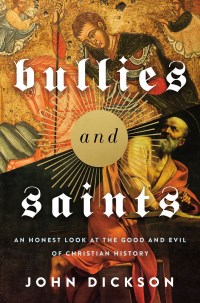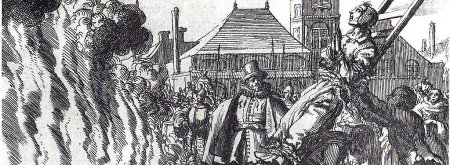An Honest Look at the Good and Evil of Christian History
Ever wondered what the Church was up to when thousands took up arms, charging off to ‘liberate’ Jerusalem and massacre anyone who got in their way? Ever wondered how priests could use torture to exact ‘confessions’ during the Spanish Inquisition? More embarrassingly, ever been stuck for an honest answer when your friend says wistfully to you: ‘I think I could have been a Christian if it weren’t for the terrible things the Church has done’? If so, this book could be for you.
 It was a book I took particular interest in, having written one on the same topic not so long ago precisely because a friend said this.[1] It’s not an easy topic, but Dickson handles it magnificently, with proportionate humility, shame and some muted pride. His style is refreshingly down-to-earth and he never assumes too much of the reader, even though much of the book is about periods of history that few are well versed in. Dickson teaches history, is a podcaster and presenter as well as a popular speaker so he knows how to hold his audience.
It was a book I took particular interest in, having written one on the same topic not so long ago precisely because a friend said this.[1] It’s not an easy topic, but Dickson handles it magnificently, with proportionate humility, shame and some muted pride. His style is refreshingly down-to-earth and he never assumes too much of the reader, even though much of the book is about periods of history that few are well versed in. Dickson teaches history, is a podcaster and presenter as well as a popular speaker so he knows how to hold his audience.
What is surprising is that rather few Christians seem to realise that the scandalous behaviour of elements of the Church through various periods of history has become an immense (apparent) stumbling-block to faith for many people. This is not to say that if these things had not happened each of those people would be in church on Sunday but rather to state that if the Church today is to have credibility it must face up to its history – for better or worse.
My own view is (and Dickson just about reaches this point) that the world is an incomparably better place with the Church, warts and all, than without it. Let’s see what Dickson puts in the balance and how much the Church is found wanting.
Honest about the Crusades
Dickson begins with the horror story of the First Crusade. In July 1099 ten thousand Crusaders burst through Jerusalem’s walls, and one of the leaders wrote that ‘It was a just and splendid judgement of God that this place should be filled with the blood of the unbelievers’ (p3). And it was filled. Nothing can reconcile us to this sort of religious opinion today. But the difficulty for the historian is that current simplistic accounts of events, on both sides of the equation, continue to produce wrong attitudes and therefore behaviours today. Christopher Tyerman, a leading Oxford authority on the Crusades is quoted: ‘Most of what passes in public as knowledge of the Crusades is either misleading or false’ (p4).
Dickson handles the subject magnificently, with proportionate humility, shame and some muted pride
What does seem certain is that the start of these wars is the beginning of a remarkable new theology in Christianity: ‘salvation is found in fighting the infidel’ (p6). After a ‘nutshell’ history of the campaigns, Dickson sets out to explore how this error came about. The odd thing is, it was not a doctrine that was founded on success. By any measure, the Crusades to the Holy Land were a military and political failure. By 1244 Jerusalem was back in Muslim hands and remained so until British troops under Allenby entered the city in 1917.
Dickson’s explanation is that Christianity is not a culturally specific religion. There are no categories of people with whom Christians may not associate. This, on the one hand, makes it easily transportable and on the other makes it vulnerable to the desire to fit in with its host culture. We are reminded of Paul’s principle: ‘To the Jews I became as a Jew, in order to win Jews’ (1 Corinthians 9:20). ‘Something like this happened on a grand scale in the Middle Ages’ (p169) the author concludes some 150 pages later: ‘As the church sought to win pagan warrior cultures to the faith…it somehow managed to transform Jesus into the ultimate “war-lord” and his church into the “knights of Christ”’ (p169). It’s a plausible enough idea and one that fits with church history generally which has been a repetitive series of revolution, partial decay and decline followed by reform. This is inevitable when the Church has to be ‘in the world but not of it’ (John 17:14–18) and has to remain ‘unspotted by the world’ (James 1:27). Any such stance, when it fails, will generally fall towards the prevailing culture, not away from it. The Crusades were not unique in that respect.
Listening to ‘the beautiful tune’
Having got the Crusades off his chest, as it were, Dickson gives us 150 pages on the thousand years that precede them, a period that few Christians are well informed about. The more’s the pity as they are centuries of astonishing interest and achievement with far more in the credit balance than the debit.
What Dickson calls ‘The Beautiful Tune’ of Christ’s teaching is the bedrock of so much of this period. We are challenged to find ‘a block of teaching from anywhere in the pre-modern world that matches Christ’s emphasis on love and mercy toward everyone, including enemies’ (p27). That teaching, says Dickson, ‘finds its clearest expression…on a cross, not as a martyr for a cause but as a Saviour taking the place of sinners’ (p.29). And underlying the Christian’s behaviour towards others in this period is Imago Dei, the biblical teaching that every human bears the image of the creator. This meant that even the pagans noticed how this new sect cared for all, opposed infanticide,[6] supported women and began the long process of opposing slavery. Ultimately it influenced the wording of the 1948 Universal Declaration of Human Rights.[7]
That’s not a bad record to kick off with. But there were costs. Dickson is very good on the periods of persecution that Christians endured both before and after Constantine’s Edict of Milan in ad 313 which allowed tolerance for all religions. One of the strengths of the book is its inclusion of details from contemporary official transcripts which allow us to see first-hand just what ordinary Christians had to go through. Such periods produced extraordinary bravery both physically and intellectually. Tertullian, for example (ad 160–225), brilliantly used his rhetorical gifts as a lawyer to deter the proconsul of Carthage from further torture and execution of thousands of Christians while identifying himself as one of their number. Porphyry, one of the persecutors under Diocletian, is described by Dickson as ‘Richard Dawkins, Christopher Hitchens, and Sam Harris rolled into one’ (p.53) – the difference being of course that if their victims did not sacrifice to the gods they would be tortured and executed. Laws about human rights did not exist: they were the gift of the Church to a world that rejected their origin.
Christians as ‘good losers’
Before we leave this period it is worth drawing attention to the author’s handling of Constantine, who is often seen as the origin of most things that went wrong: the accretion of power in church hierarchy. Dickson is right not to lay the blame entirely at his feet. His Edict guaranteed tolerance for all faiths – the result of the Christian thinker Lactantius (AD 240–320) who argued that coerced religion was the opposite of true religion. Where I am less certain that Dickson is right is in his assessment of what twenty-first century legislation allows. He writes: ‘Most of us, all these years later, take for granted that the state will grant complete freedom in spiritual matters’ (p63). Writing from an Australian perspective he may have that luxury. In Britain, there are many who would beg to differ. In recent years there have been job losses, court actions, arrests and intimidation simply as the result of Christians expressing a biblical opinion, or even as the result of an unfounded allegation – which is in contravention of no British law. One has just taken place as I write.[8] Freedom of expression and indeed belief is by no means currently guaranteed in this country. Even after Constantine, one persecuting Emperor (Julian) decreed in AD 362 that all ‘masters of studies’ be directly approved by him – effectively a ban on Christian instructors in schools. Given that education is such a political football in this country and the power of vocal minorities to sway public opinion as well as a general and rapid shift in public attitudes towards the Church’s role in society, no Christian should imagine this to be merely in the realms of fiction.[9]
Eighty years after Constantine however, under Theodosius I, pagans were, in turn, having to plead for their shrines to be tolerated. They had become illicita – illegal. Yet hand in hand with this, Lactantius’s dictum (based of course on Christ’s teaching) ‘Give to the blind, the sick, the lame and the destitute…Men may have no use for them, but God has’, (which was quite without precedent in the ancient world) (p.78), continued the process of transforming that world through the Church’s altruism. The machinery of hospitals, hostels, schools, orphanages, charities and the equivalent of food banks was just getting under way, never to disappear even in the darkest times. Dickson has the big guns on his side in claiming this and quotes figures such as Teresa Morgan, Professor of Graeco-Roman History at the University of Oxford in support. She writes that at the time there were ‘no social safety nets. But Christians create social safety nets… looking after the widows, the poor, the orphans, the people who in most of society are just slung out onto the street’ (p.80).
So, for three hundred years Christians had been ‘good losers.’ The story of how they became ‘bad winners’ in Dickson’s phrase occupies much of the rest of the book. It has much to recommend it but some limitations which are important for readers to realise.
Refusing to accept simplistic answers
Points for applause for the book continue with Dickson's refusal to accept simplistic answers to complex questions (e.g. the eradication of slavery), his uncovering of out-of-the-way significant curiosities (e.g. it was Constantine as well as Moses who gave us the week-end off work; by the year 300 probably 10% of the Empire was Christian; to get baptised in Rome in AD 200 you needed to complete 144 hours of lectures before your dip), unusual linkings of events (e.g. the death of Geoge Floyd in 2020 USA with riots in Alexandria in AD 391), and his informal style which invigorates the reading.
Bullies and Saints is one of the few histories that meets head-on the current vogue for secular or anti-Christian authors to misrepresent well-authenticated historical accounts for their own purposes – a trend that Christian readers need to learn to beware of. ‘Today’s perception of the [historic] church as [being] opposed to “secular” scholarship does not fit with our ancient evidence. Christian philosophers were, in fact, one key factor in the church’s success among pagan elites’, Dickson warns (p.90). The journalist and author Catherine Nixey provides a good example of this vogue. She tells the story of the murder of fifth century philosopher Hypatia, who she claims was hated by the church ‘because she taught secular philosophy’ and because she was a woman (p.120). Dickson then demolishes this claim over the next few pages and shows that ‘our earliest and best evidence for the event is a Christian source that lauds Hypatia as the intellectual superior of all other (male) philosophers’ (p.123).
Dickson refuses to accept simplistic answers to complex questions
Another example is Harvard’s Stephen Greenblatt whose thesis in 2011 was the (now almost hackneyed) claim that the church for centuries suppressed the literary classics of Greece and Rome until a fifteenth century Humanist scholar ‘tore away the veil of ignorance the church had cast’ (p.155) thereby creating ‘the swerve’ that led to the modern world. Dickson then cites five expert reviewers who realised Greenblatt ‘offered an account of the Middle Ages that is unrecognisable to specialists of the period’ (p.157). But the falsehood of Greenblatt’s work is blatant: scholars of the day knew where to find precious manuscripts: in a Christian monastery! Instead of destroying them as Greenblatt claims they were carefully preserved and valued. Dickson is right in making the real ‘swerve’ much earlier – at the time of Alcuin (AD 735-804). It was Alcuin at the court of Charlemagne who put education, communication, tolerance and Christian belief back at the heart of Europe. There is a fascinating direct linkage between our ability to type modern fonts like this and the monk St. Benedict (AD 480–550) via the Venerable Bede which the author does not mention.[10] Alcuin is the central and epoch-changing centre of that chain. The story is a marvellous encapsulation of how the monastic tradition has benefitted all of us.
Dickson’s treatment of the Spanish Inquisition is in keeping with the rest of the book: properly historical, avoiding the clichés of the press about the ‘millions’ of secular martyrs, but entirely accepting its horrors. Nevertheless, he says, ‘in a fair-minded history of violence from the Middle Ages to today, the Inquisitions would not even make the Top Ten’ (p.220). Quoting a variety of expert sources Dickson shows (as is well known to historians) that by the laws of the time Inquisitors were meticulous in their fairness and tended to be lenient – ‘a source of great frustration to secular rulers’ (p.222). This is not to deny that any act of torture in the name of Christ is a blasphemy and that monsters like Torquemada were utterly repellent in their beliefs and behaviour. Anyone who finds this episode of history a particular problem would do well to read this chapter. It is, for instance, worth knowing that the atheist regime in France during the Reign of Terror (1793–4) executed 17,000 victims in less than a year whereas during the worst part of the Spanish Inquisition about 2,000 victims were executed in 50 years (p.228–9).
There follows a short chapter on the Reformation and the ‘Wars of Religion’ in the earlier 1600s which is useful in explaining the largely political rather than religious nature of those thirty years of warfare that killed so many. From there Dickson, in one of the most surprising leaps in the book, moves straight to ‘The Troubles’ in twentieth century Ireland. This seems to me to be almost the only weakness in the book. The leap from seventeenth to twentieth century is a leap too far and one that means that Dickson misses an enormous opportunity.
Missing the positive side
At the end of the book the author acknowledges that the non-believer Tom Holland, in his famous history of Christendom, Dominion: The Making of the Western Mind ‘offers a far more flattering history of Christianity than the one I have’ (p.285) and it is not hard to work out why Dickson, a committed and vocal Christian, has allowed this to be so: he is utterly determined to face up to the worst that the church has done. The pity is that despite a very positive chapter on Christianity’s current ‘social capital’ he has omitted so much of what the church has achieved in terms of social betterment in the last two centuries.
A hugely useful book which combines readability with scholarship and offers a challenge to Christian and non-Christian alike
No history of the church which seeks to balance its good impact with its negative can respectably leave out John Wesley and Methodism, who the Cambridge Modern History describes as the greatest man of his times (spanning the eighteenth century) and transforming the nature of his country. Here is a success story of the greatest proportions just begging to be told. Where, we might also ask is an account of the struggles of Wilberforce, of the Evangelicals and others to abolish slavery, to improve the lot of the poorest, to improve factory conditions, to found charities of every kind, to educate, to relieve the suffering of the least privileged throughout Africa and Asia? For two hundred years the church has been transformative for good worldwide in the lives of millions. The concluding part of this book would have been a great platform to re-tell this story which, like John Wesley’s, is neglected or mis-told by those with an agenda no less deliberate than that of the church. It's impossible to cover everything, but after shining so bright a light on the dark side of things, why not spotlight the glories in an age which has chosen to look away from them?
Aside from this, Bullies and Saints is a hugely useful book which combines readability with scholarship and offers a challenge to Christian and non-Christian alike. Christians need to ask themselves how best to avoid the modern equivalent of past disasters. Non-Christians need to accept the positive impact of the church and ask themselves why some of their number are so keen to obliterate these. There have, however, been many figures on both sides of the divide who have been good listeners and tolerant neighbours. In a fragile and volatile world we all need to learn from the past and emulate them
John Dickson, Bullies and Saints: an Honest Look at the Good and Evil of Christian History (Zondervan 2021)
References
[1] The Evil That Men Do (Sacristy Press, 2016)
[2] C S Lewis, Present Concerns (Ed. Walter Hooper, Fount, 1986) p.13
[3] G Chaucer, General Prologue to the Canterbury Tales (Ed. J Winny, Cambridge University Press, 1965) ll. 61 ff. See also (from the same period) W Langland, Piers the Ploughman (Trans. J F Goodridge, Penguin, 1966) p.82
[4] C.S. Lewis, Present Concerns (Ed. Walter Hooper, Fount, 1986) p.16
[5] C.S. Lewis, Present Concerns (Ed. Walter Hooper, Fount, 1986) p.16. The comment fits as well as ever today in response to thinkers such as Steven Pinker.
[6] The practice became unlawful in AD 374 throughout the Empire. With the disappearance of the Imago Dei doctrine in recent years, calls for the legitimisation of infanticide have now returned. See The Evil That Men Do p.221
[7] This of course was inevitably influenced by statements about freedom of religion in the American Declaration of Independence (1776) – most famously: ‘all men are created equal …endowed by their Creator with certain unalienable Rights’ - which scholarship now considers beyond reasonable doubt to have been influenced to some degree by Tertullian’s ‘It is a fundamental human right…that every man should worship according to his own convictions’. See p.67
[8] Media commentator Caroline Farrow arrested by police over gender Twitter spat (gbnews.uk)
[9] Dickson cites a poll in which 61% considered religion a force for harm rather than good. See p.11
[10] See The Evil That Men Do pp.58-61



